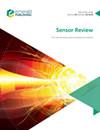用于电阻应变力传感器的弹性体动态特性优化
IF 1.6
4区 工程技术
Q3 INSTRUMENTS & INSTRUMENTATION
引用次数: 0
摘要
目的 本文旨在提供一种通过弹性体结构设计和优化来研究和改进四柱电阻应变力传感器动态特性的新方法。然后,作者根据 Solidworks 有限元仿真结果对模型进行了验证和修改。结论 Solidworks 有限元仿真和锤击动态实验结果表明,模型的相对误差小于 10%,证实了模型的准确性。原创性/价值作者首次提出了四柱弹性体的动态特性模型,并基于机理分析方法成功优化了四柱传感器。并提供了一种研究和改进电阻动态特性的新方法。本文章由计算机程序翻译,如有差异,请以英文原文为准。
Dynamic characteristics optimization of elastomer for resistance strain force sensor
Purpose
This paper aims to provide a new method to study and improve the dynamic characteristics of the four-column resistance strain force sensor through the elastomer structure design and optimization.
Design/methodology/approach
Based on the mechanism analysis method, the authors first present a dynamic characteristic model of the four-column resistance strain force sensors’ elastomer. Then, the authors verified and modified the model according to the Solidworks finite element simulation results. Finally, the authors designed and optimized two types of four-column elastomers based on the dynamic characteristic model and verified the improvement of sensor dynamic performance through a hammer knock dynamic experiment.
Findings
The Solidworks finite element simulation and hammer knock dynamic experiment results show that the relative error of the model is less than 10%, which confirms the accuracy of the model. The dynamic performance of the sensors based on the model can be improved by more than 30%, which is a great improvement in sensor dynamic performance.
Originality/value
The authors first present a dynamic characteristic model of the four-column elastomer and optimize the four-column sensors successfully based on the mechanism analysis method. And a new method to study and improve the dynamic characteristics of the resistance is provided.
求助全文
通过发布文献求助,成功后即可免费获取论文全文。
去求助
来源期刊

Sensor Review
工程技术-仪器仪表
CiteScore
3.40
自引率
6.20%
发文量
50
审稿时长
3.7 months
期刊介绍:
Sensor Review publishes peer reviewed state-of-the-art articles and specially commissioned technology reviews. Each issue of this multidisciplinary journal includes high quality original content covering all aspects of sensors and their applications, and reflecting the most interesting and strategically important research and development activities from around the world. Because of this, readers can stay at the very forefront of high technology sensor developments.
Emphasis is placed on detailed independent regular and review articles identifying the full range of sensors currently available for specific applications, as well as highlighting those areas of technology showing great potential for the future. The journal encourages authors to consider the practical and social implications of their articles.
All articles undergo a rigorous double-blind peer review process which involves an initial assessment of suitability of an article for the journal followed by sending it to, at least two reviewers in the field if deemed suitable.
Sensor Review’s coverage includes, but is not restricted to:
Mechanical sensors – position, displacement, proximity, velocity, acceleration, vibration, force, torque, pressure, and flow sensors
Electric and magnetic sensors – resistance, inductive, capacitive, piezoelectric, eddy-current, electromagnetic, photoelectric, and thermoelectric sensors
Temperature sensors, infrared sensors, humidity sensors
Optical, electro-optical and fibre-optic sensors and systems, photonic sensors
Biosensors, wearable and implantable sensors and systems, immunosensors
Gas and chemical sensors and systems, polymer sensors
Acoustic and ultrasonic sensors
Haptic sensors and devices
Smart and intelligent sensors and systems
Nanosensors, NEMS, MEMS, and BioMEMS
Quantum sensors
Sensor systems: sensor data fusion, signals, processing and interfacing, signal conditioning.
 求助内容:
求助内容: 应助结果提醒方式:
应助结果提醒方式:


